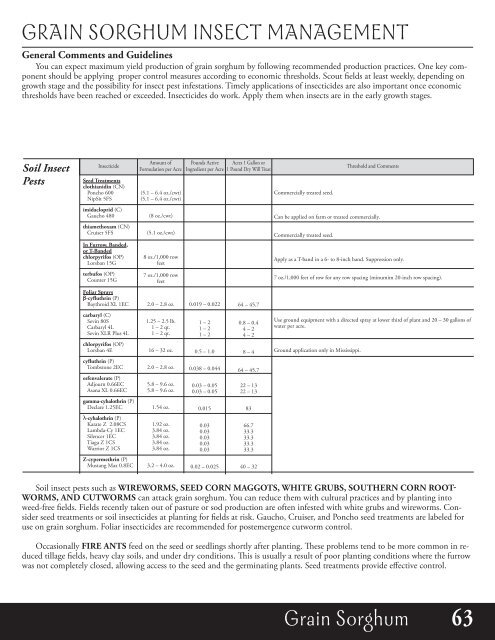Agronomic Crops
mJyPrJ
mJyPrJ
You also want an ePaper? Increase the reach of your titles
YUMPU automatically turns print PDFs into web optimized ePapers that Google loves.
GRAIN SORGHUM INSECT MANAGEMENT<br />
General Comments and Guidelines<br />
You can expect maximum yield production of grain sorghum by following recommended production practices. One key component<br />
should be applying proper control measures according to economic thresholds. Scout fields at least weekly, depending on<br />
growth stage and the possibility for insect pest infestations. Timely applications of insecticides are also important once economic<br />
thresholds have been reached or exceeded. Insecticides do work. Apply them when insects are in the early growth stages.<br />
Soil Insect<br />
Pests<br />
Insecticide<br />
seed treatments<br />
clothianidin (CN)<br />
Poncho 600<br />
NipSit 5FS<br />
imidacloprid (C)<br />
Gaucho 480<br />
thiamethoxam (CN)<br />
Cruiser 5FS<br />
In Furrow, Banded,<br />
or t-Banded<br />
chlorpyrifos (OP)<br />
Lorsban 15G<br />
terbufos (OP)<br />
Counter 15G<br />
Foliar sprays<br />
b-cyfluthrin (P)<br />
Baythroid XL 1EC<br />
carbaryl (C)<br />
Sevin 80S<br />
Carbaryl 4L<br />
Sevin XLR Plus 4L<br />
chlorpyrifos (OP)<br />
Lorsban 4E<br />
cyfluthrin (P)<br />
Tombstone 2EC<br />
esfenvalerate (P)<br />
Adjourn 0.66EC<br />
Asana XL 0.66EC<br />
gamma-cyhalothrin (P)<br />
Declare 1.25EC<br />
λ-cyhalothrin (P)<br />
Karate Z 2.08CS<br />
Lambda-Cy 1EC<br />
Silencer 1EC<br />
Tiaga Z 1CS<br />
Warrior Z 1CS<br />
Z-cypermethrin (P)<br />
Mustang Max 0.8EC<br />
Amount of<br />
Formulation per Acre<br />
(5.1 – 6.4 oz./cwt)<br />
(5.1 – 6.4 oz./cwt)<br />
(8 oz./cwt)<br />
(5.1 oz./cwt)<br />
8 oz./1,000 row<br />
feet<br />
7 oz./1,000 row<br />
feet<br />
2.0 – 2.8 oz.<br />
1.25 – 2.5 lb.<br />
1 – 2 qt.<br />
1 – 2 qt.<br />
16 – 32 oz.<br />
2.0 – 2.8 oz.<br />
5.8 – 9.6 oz.<br />
5.8 – 9.6 oz.<br />
1.54 oz.<br />
1.92 oz.<br />
3.84 oz.<br />
3.84 oz.<br />
3.84 oz.<br />
3.84 oz.<br />
3.2 – 4.0 oz.<br />
Pounds Active<br />
Ingredient per Acre<br />
0.019 – 0.022<br />
1 – 2<br />
1 – 2<br />
1 – 2<br />
0.5 – 1.0<br />
0.038 – 0.044<br />
0.03 – 0.05<br />
0.03 – 0.05<br />
0.015<br />
0.03<br />
0.03<br />
0.03<br />
0.03<br />
0.03<br />
0.02 – 0.025<br />
Acres 1 Gallon or<br />
1 Pound Dry Will Treat<br />
64 – 45.7<br />
0.8 – 0.4<br />
4 – 2<br />
4 – 2<br />
8 – 4<br />
64 – 45.7<br />
22 – 13<br />
22 – 13<br />
83<br />
66.7<br />
33.3<br />
33.3<br />
33.3<br />
33.3<br />
40 – 32<br />
Commercially treated seed.<br />
Threshold and Comments<br />
Can be applied on farm or treated commercially.<br />
Commercially treated seed.<br />
Apply as a T-band in a 6- to 8-inch band. Suppression only.<br />
7 oz./1,000 feet of row for any row spacing (minumim 20-inch row spacing).<br />
Use ground equipment with a directed spray at lower third of plant and 20 – 30 gallons of<br />
water per acre.<br />
Ground application only in Mississippi.<br />
Soil insect pests such as WIReWoRMs, seeD CoRn MAGGots, WHIte GRUBs, soUtHeRn CoRn Root-<br />
WoRMs, AnD CUtWoRMs can attack grain sorghum. You can reduce them with cultural practices and by planting into<br />
weed-free fields. Fields recently taken out of pasture or sod production are often infested with white grubs and wireworms. Consider<br />
seed treatments or soil insecticides at planting for fields at risk. Gaucho, Cruiser, and Poncho seed treatments are labeled for<br />
use on grain sorghum. Foliar insecticides are recommended for postemergence cutworm control.<br />
Occasionally FIRe Ants feed on the seed or seedlings shortly after planting. ese problems tend to be more common in reduced<br />
tillage fields, heavy clay soils, and under dry conditions. is is usually a result of poor planting conditions where the furrow<br />
was not completely closed, allowing access to the seed and the germinating plants. Seed treatments provide effective control.<br />
Grain Sorghum 63


